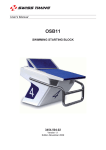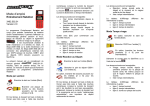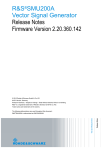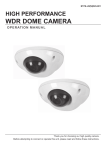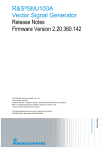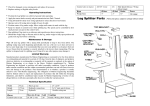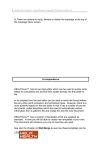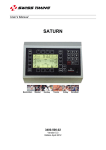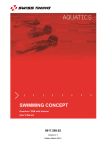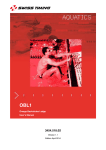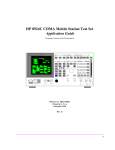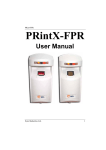Download OSB 11
Transcript
OSB 11 Swimming Starting Block User’s Manual 3454.504.02 Version 1.3 Edition February 2014 Caution and safety precautions Never use any other charger than the supplied or a type approved by Swiss Timing. This could destroy the battery, cause damage to unit, and possible cause personal injury due to fire or/and electrical shock. Never bypass a power cord ground lead by breaking off the ground pin, or by using inappropriate extension cords or adapters. Never plug a power cord into the AC power source until you have made sure that all installation, cabling and power levels, are proper, and that the applicable procedures in this manual have been followed. Protect the equipment against splashing, rain and excessive sun rays. Never use the device if it is damaged or insecure. Verify the selection of the power distribution. Verify that the voltage quoted on the rating plate is the same as your voltage. Connect the appliance only to power sockets with protective earth. The use of incorrect connection voids warranty. This program may be modified at any time without prior notification. Do not open the case; there is nothing that needs servicing inside it. Nevertheless, if the case must be opened, you must call for some qualified personnel. The power supply cable must be disconnected before opening the case. During the transport of all Swiss Timing equipment delivered with a reusable carry case, the said case should be used at all times. This is imperative to limit the damage, such as shocks or vibration that can be caused to the units during transport. The same cases should also be used when returning equipment to Swiss Timing for repair. Swiss Timing reserves the right to refuse all guarantees if this condition is not fulfilled. If the installation includes a horn, be sure to maintain a sufficient security distance from the public. Documentation Updates Swiss Timing Ltd. reserves the right to make improvements in the products described in this documentation at any time without prior notice. Furthermore, Swiss Timing Ltd. reserves the right to revise this documentation in its content at any time and without any obligation to notify any person or organization of such revision. Disclaimer The information provided in this documentation has been obtained from sources believed to be reliable, accurate and current. However, Swiss Timing Ltd. makes no representation or warranty, express or implied, with respect, but not limited to, the completeness, accuracy, correctness and actuality of the content of this documentation. Swiss Timing Ltd. specifically disclaims any implied warranty of merchantability, quality and/or fitness for any particular purpose. Swiss Timing Ltd. shall not be liable for errors contained in this documentation or for incidental or consequential damages in connection with the supply, performance or use of this documentation. Environment This symbol indicates that this product should not be disposed with household waste. It has to be returned to a local authorized collection system. By following this procedure you will contribute to the protection of the environment and human health. The recycling of the materials will help to conserve natural resources. Copyright © Swiss Timing Ltd. All rights reserved. This documentation may not, as a whole or in part, be copied, translated, reproduced, transmitted or reduced and/or stored to any electronic medium or machine-readable form without the prior written consent of Swiss Timing Ltd. Swimming Starting Block / OSB 11 TABLE OF CONTENTS 1 2 INTRODUCTION........................................................................................................... 1 1.1 Construction of the OSB11-RBD starting block (Relay Break Detection) ...................... 2 1.2 Construction of the OSB11 starting block without start control ...................................... 3 1.3 Fixation material of the starting block ............................................................................ 4 INSTALLATION ............................................................................................................ 5 2.1 Positioning of the OSB11 starting blocks ...................................................................... 5 2.2 Fixation of the starting block ......................................................................................... 6 2.3 Drilling and mounting of the OSB11 .............................................................................. 6 3 TECHNICAL CHARACTERISTICS OF THE OSB11-SW WITH RELAY BREAK DETECTION (RBD) AND WITHOUT START CONTROL ............................................ 7 4 CONTROL AND MAINTENANCE OF THE STARTING BLOCK ................................. 8 4.1 Control without application of pressure ......................................................................... 8 4.2 Pressure sensitivity control ........................................................................................... 8 4.3 Connection to the timing system ................................................................................... 8 4.4 Inspection ..................................................................................................................... 9 4.5 Troubleshooting (detection of a short circuit) ................................................................ 9 4.6 Troubleshooting (no contact) ........................................................................................ 9 4.7 Sensitivity adjustment ................................................................................................... 9 4.8 Assembly of the RBD and platform ............................................................................. 10 4.9 Dismantling of the top ................................................................................................. 11 5 PREVENTION AND MAINTENANCE ................................................................ 13 6 APPENDIX .................................................................................................................. 15 6.1 Abbreviations and symbols ......................................................................................... 15 6.2 Index figures ............................................................................................................... 15 6.3 Version history ............................................................................................................ 15 SWISS TIMING LTD P.O. Box 138, rue de l'Envers 1 CH-2606 Corgémont Switzerland Phone +41 32 488 36 11 www.swisstiming.com [email protected] Swimming Starting Block / OSB 11 1 INTRODUCTION OBS11 presents a powerful new patented feature, revolutionising the way the swimmers start from their blocks. Diving from the starting block with the body propelled by the knee at a 90° angle drastically increases the explosiveness of the start. Physical tests undertaken by top level swimmers showed faster races versus a standard block. OSB11 starting blocks have been tested by world-class swimmers, who have helped to specify the optimum angles of both the platform and the footrest for racing starts. Design research also applied to the top surfaces, very comfortable yet rough enough to guarantee the swimmer a feeling of total security. The length of the platform is extended to 74cm to accommodate to the new styles of start. The diameter and position of the handgrips have also been carefully considered to respond to all the requirements of different hand positions. A door at the back of the block allows easy access to the interior to connect the cabling. . OSB11 starting blocks benefit from a new design and an attractive color scheme. Version 1.3 3454.504.02 Page 1 1.1 Construction of the OSB11-RBD starting block (Relay Break Detection) 1. 3454.013 Starting block 2. 3454.014 Rear door 3. 3454.012 Platform with footrest 4. 3454.600 Complete RBD 3454.010 Upper frame 3454.011 Lower frame 2659.056 Rubber shock absorber (Silentblock) 3393.018 Spring loaded contact 3393.019 Contact screw 3393.020 Adjustment screw 3393.021 Isolation plate 3393.022 Isolation washer 3393.601 Connection cable 5. A4 self-blocking nut M8 (9557.1505) + A4 washer M8 (9580.1614) for platform fixing 6. 3454.015 Handle 7. Fixation material (see paragraph 1.3) 3454.716 Material 6 lines 3454.718 Material 8 lines 3454.720 Material 10 lines Figure 1 - OSB11-RBD Page 2 3454.504.02 Version 1.3 Swimming Starting Block / OSB 11 1.2 Construction of the OSB11 starting block without start control 1. 3454.013 Starting block 2. 3454.014 Rear door 3. 3454.012 Platform with footrest 4. 3454.019 Intermediate plate 5. A4 self-blocking nut M8 (9557.1505) + A4 washer M8 (9580.1614) 6. 3454.015 Handle 7. Fixation material (see paragraph 1.3) 3454.716 Material 6 lines 3454.718 Material 8 lines 3454.720 Material 10 lines Figure 2 - OSB11 without start control Version 1.3 3454.504.02 Page 3 1.3 Fixation material of the starting block 1. 3454.030 2. 9051.9803 9051.9008 9051.9814 3. 9039.8582 4. 3454.032 5. 3454.031 Drilling gauge Drill ∅5 Drill ∅10 Drill ∅16 Anchor with internal thread M8 x 90 (4x) Stainless steel washer M8 (4x) Hexagon head stainless steel screw M8 x 40 (4x) Figure 3 - Fixation of the starting block Page 4 3454.504.02 Version 1.3 Swimming Starting Block / OSB 11 2 INSTALLATION 2.1 Positioning of the OSB11 starting blocks The OSB11 starting blocks are positioned according to the measures indicated: 400mm from the swimming pool border (410mm with the OCP5 touchpad) to the front of the base. The handle of the OSB11 must be aligned with the border of the touchpad (for example OCP5). Are the touch plates missing or is the swimming pool too small with touchpads, align the OSB11 starting block with the border of the swimming pool. The drilling oblong fixations permit a play of the block of +/-10mm; this permits a possible correction of the alignment. Swimming Pool as per FINA regulations Figure 4 - Positioning of the OSB11 Version 1.3 3454.504.02 Page 5 2.2 Fixation of the starting block To ensure proper functioning of the OSB11 starting block system, fixation must be absolutely rigid. 2.3 Drilling and mounting of the OSB11 For fix cabling, a hole with Ø120 - 122mm at 570mm away from the pool's border must be foreseen in order to provide space for the cables (the gauge has a hole of Ø120mm). Put the drilling gauge (1) on the border of the swimming pool and mark the 4 Ø5 holes of the gauge with a Ø5 drill. Drill the 4 holes respectively with drills ∅5, ∅10 and ∅16mm (2). Minimal depth: 90mm, maximal depth: 100mm. As per instruction manual 3393.505 "Preparing the drillings", push the pegs M8 (3) in the ∅16 holes and put the OSB11 starting block on the 4 fixation points. Fix the base with the 4 screws M8 x 40 (5) and the 4 washers M8 (4). Figure 5 - Fixation of the OSB11 Page 6 3454.504.02 Version 1.3 Swimming Starting Block / OSB 11 3 TECHNICAL CHARACTERISTICS OF THE OSB11-SW WITH RELAY BREAK DETECTION (RBD) AND WITHOUT START CONTROL OSB11-RBD OSB11-Simple DIMENSIONS 780 x 570 x 650 Platform 740mm x 520mm WEIGHT (KG) 47 COLOURS CONTACT ACTION FORCE CONNECTION 41 Platform white RAL 9010 with non-skidding surface dark blue RAL 5002 Closing at the moment of the start (NO) 13.0 Kg to 18.0Kg Cable with 2-pole plug (length ~140cm) Figure 6 - Technical characteristics Version 1.3 3454.504.02 Page 7 4 CONTROL AND MAINTENANCE OF THE STARTING BLOCK 4.1 Control without application of pressure Connect the buzzer (11) to the connection cable (9). If there is no pressure on the platform, the buzzer (11) remains silent. If the buzzer (11) emits a sound, proceed as described in paragraph 4.5. 4.2 Pressure sensitivity control Press with the Dynamometer (12) against the middle of the platform (3). Read on the Dynamometer (12) the pressure necessary to activate the buzzer (11). If the sensitivity is out of the range of 13kg and 18kg, see paragraph 4.7. 4.3 Connection to the timing system If a satisfactory result has been obtained in tests 4.1 and 4.2, connect the connection cable (9) to the timing system. Figure 7 - Maintenance Page 8 3454.504.02 Version 1.3 Swimming Starting Block / OSB 11 4.4 Inspection Every 6 months: check cable connections. Once a year: check rigidity of block fixation. 4.5 Troubleshooting (detection of a short circuit) If the buzzer (11) emits a sound while there is no pressure on the platform, proceed as follows: Unscrew the 4 nuts M8 (7) under the platform (3). Remove platform (3) and connect the buzzer (11) to the connection cable (9). Insert a screwdriver into the 2 holes of the lower frame (4) and unscrew each of the adjustment screws (6) until they do not touch the contact head any more. If the sound continues, verify if there is a short circuit on the cable or between the fixed and mobile frame (mechanical or electrical connection). 4.6 Troubleshooting (no contact) If the buzzer (11) does not emit a sound during the sensitivity adjustment, proceed as follows: Make sure that the platform and the RBD are correctly assembled; there must be a visible movement (Paragraph 4.8). Make sure that the 2 adjustment screws are not too far apart. 4.7 Sensitivity adjustment If the sensitivity is out of the range of 13kg and 18kg (as indicated in paragraph 4.2), make an adjustment by proceeding as follows: Connect the buzzer. Insert a screwdriver in one of the holes of the lower frame (4) then screw the adjustment screw (6), facet after facet of the hexagonal head until the buzzer emits a sound. Unscrew the adjustment screw by turning it 4 facets backwards (0,16mm/facet). Adjust the second screw in the same way. Make a test with the Dynamometer (12) by pushing or pulling the upper frame (4). If the measured pressure is higher than 18kg, continue screwing the screw in and test at every facet. If pressure is lower than 13kg, unscrew and test at every facet. It is recommended to proceed systematically with the adjustment to obtain a regular play between the 2 contacts. Version 1.3 3454.504.02 Page 9 4.8 Assembly of the RBD and platform When assembling the RBD and the platform, insert the screws but do not tighten them, push the RBD to the maximum forwards (towards the handle) and tighten. Make sure the required distances between the base and the RBD/platform are correct. Required distance between base and RBD: 21 to 22mm. Do the same with the platform. Required distance between base and platform: 4 to 5mm. Figure 8 - Assembly Page 10 3454.504.02 Version 1.3 Swimming Starting Block / OSB 11 4.9 - Dismantling of the top Unscrew the platform by removing the 6 nuts indicated in green located under the top and inside the base. Do not unscrew nuts indicated in red. Instruction for dismantling the footrest - Position the footrest on number 3 to access the screws between the footrest and the guides. Figure 9 - Dismantling of the footrest Version 1.3 3454.504.02 Page 11 - Rotate the top to access the lateral screws. - Unscrew the 4 screws (2 on each side). Figure 10 - Dismantling of the footrest - Pull to remove the footrest then remove the guides. - To reassemble the footrest, start from this point and follow the instructions backwards. Page 12 3454.504.02 Version 1.3 Swimming Starting Block / OSB 11 5 PREVENTION AND MAINTENANCE Equipment installed in aquatic complex, often sealed with a high moisture level, require special attention in regards to their maintenance. In fact, the stainless steel parts found on ladders, fences or swimming starting blocks can have corrosion if they are not frequently cleaned. REMEDIATION MAINTENANCE Stainless steel is an excellent product that needs to be very clean to keep its stainless quality. When you receive your new equipment, it is important to establish a maintenance program to avoid the stainless steel parts to deteriorate. Indeed, lack of maintenance can make the chromium oxide film inefficient, which could cause corrosion on your equipment. A dirty surface is the biggest ally of corrosion and your biggest enemy. Dirt, grease and deposit left by users or by contaminated water deposit must be removed by cleaning the surface with fresh water (do not use the pool’s water) using a high-pressure cleaner and wiping, if possible, with a clean dry cloth. A basic cleaning of the starting blocks’ inner and outer surfaces (without disassembly) must be done regularly, preferably every week, if possible using a high pressure cleaner. A thorough cleaning with removal of the top (see manual) must be done regularly, several times a year, depending on the degree of contamination of the stainless steel. You must pay extra attention to the RBD (Relay Break Detection) and the handles (backstroke start). Concerning dismantling, it is imperative to use tools that are specially dedicated to stainless steel. If your equipment is already showing significant dirt deposits, you need to get rid of them in order that the oxygen from the air gets in contact with the chromium in the stainless steel to form the protective chromium oxide film. A thorough cleaning with fresh water using a high-pressure cleaner is normally sufficient. If some dirt remains, rub with a nylon pad or a cotton cloth. Make sure the pad you use is not rough to prevent it damaging the protective film or the aesthetic finish of the product. After a thorough cleaning, clean the stainless steel with fresh water twice a week during a few months and then decrease the frequency. Never use a metal brush, steel wool, emery paper or any abrasive material to clean. Indeed, stainless steel would be contaminated by a large quantity of undesirable particles which inevitably would cause rust stains. OSB properly maintained Version 1.3 OSB poorly maintained 3454.504.02 Page 13 REMINDER • • • • • • A weekly basic cleaning is required. A thorough cleaning must be done regularly, several times a year. You must use fresh water for cleaning. Never use abrasive material to clean the stainless steel parts. Drying the stainless steel parts must be done using a clean dry cloth. Use specially dedicated stainless steel tools for dismantling the starting blocks. Page 14 3454.504.02 Version 1.3 Swimming Starting Block / OSB 11 6 APPENDIX 6.1 Abbreviations and symbols Abbreviations Symbols 6.2 Index figures Figure 1 - OSB11-RBD ................................................................................................................... 2 Figure 2 - OSB11 without start control ............................................................................................ 3 Figure 3 - Fixation of the starting block ........................................................................................... 4 Figure 4 - Positioning of the OSB11 ................................................................................................ 5 Figure 5 - Fixation of the OSB11 ..................................................................................................... 6 Figure 6 - Technical characteristics ................................................................................................. 7 Figure 7 - Maintenance ................................................................................................................... 8 Figure 8 - Assembly ...................................................................................................................... 10 Figure 9 - Dismantling of the footrest ............................................................................................ 11 Figure 10 - Dismantling of the footrest .......................................................................................... 12 6.3 Version history Version Date Modifications since last version 1.0 01/01/10 Initial version 1.1 01/06/10 Minor modifications 1.2 14/07/11 Modifications references washers and screws. Modification of action force. New canevas. 1.3 20/02/14 Change drawing chapter 4.9 (dismantling of the top). Addition of chapter 5 Prevention and Maintenance Version 1.3 3454.504.02 Page 15 NOTES Page 16 3454.504.02 Version 1.3 SWISS TIMING LTD P.O. Box 138, rue de l'Envers 1 CH-2606 Corgémont Switzerland Phone +41 32 488 36 11 www.swisstiming.com [email protected]





















